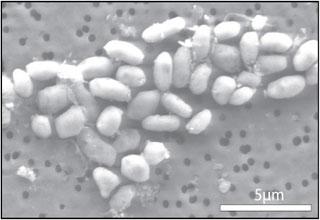
Image of GFAJ-1 grown on arsenic. Photo: NASA
WASHINGTON (AFP): Lurking in the depths of a California lake, researchers found bacteria that can thrive on arsenic, an explosive discovery that could expand the search for other life on Earth and beyond.
The NASA-funded study released Thursday redefines what science considers the necessary elements for life, currently viewed as carbon, hydrogen, nitrogen, oxygen, phosphorous and sulphur.
Not only does the bacteria survive on arsenic, it also grows by incorporating the element into its DNA and cell membranes.
"What is new here is arsenic is being used as a building block for the organism," explained Ariel Anbar, co-author of the study which appears in the online journal Science Express.
"We have had this idea that life requires these six elements with no exceptions and here it turns out, well maybe there is an exception," he said.
The discovery was made by Felisa Wolfe-Simon, a former postdoctoral scientist in Anbar's research group at Arizona State University's School of Earth and Space Exploration.
NASA's vague announcement earlier this week of a press conference on "an astrobiology finding that will impact the search for evidence of extraterrestrial life" set the Internet abuzz with speculation.
Astrobiology relates to the study of life in the universe, including its origin and evolution, where it is located and how it might survive in the future.
But Anbar acknowledged it would be quite a leap to presume the next step is discovering alien life.
"It is more the principle of the thing," he said. "Maybe there are other exceptions we should be thinking about.
"We are very influenced by life as we know it and it gets very difficult to know, how far can we push that? How different can life be and still work?"
A few years ago, Wolfe-Simon, Anbar and colleague Paul Davies began discussing the idea that different life forms could exist on Earth but by biological rules unlike ours, a notion known informally by scientists as "weird life."
The trio published their 2009 hypothesis that arsenic, which is directly below phosphorous on the periodic table, could substitute for phosphorous in Earth life forms.
"We not only hypothesised that biochemical systems analogous to those known today could utilise arsenate in the equivalent biological role as phosphate," said Wolfe-Simon.
"But also that such organism could have evolved on the ancient Earth and might persist in unusual environments today."
Wolfe-Simon then went out into the field to test the theory, collaborating with Ronald Oremland, known as a world expert in arsenic microbiology, of the US Geological Survey.
 Previous Article
Previous Article













The Indian Air Force, in its flight trials evaluation report submitted before the Defence Ministry l..
view articleAn insight into the Medium Multi-Role Combat Aircraft competition...
view articleSky enthusiasts can now spot the International Space Station (ISS) commanded by Indian-American astr..
view article